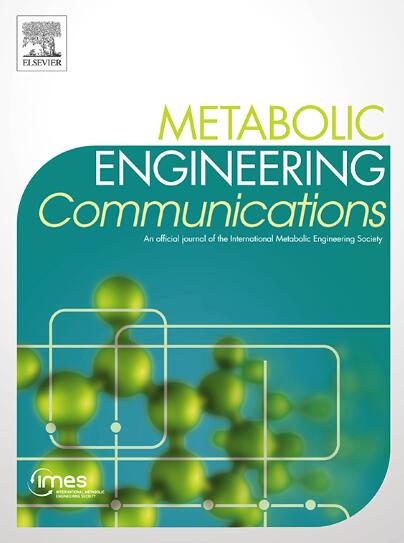Production of borneol, camphor, and bornyl acetate using engineered Saccharomyces cerevisiae
IF 4.1
Q2 BIOTECHNOLOGY & APPLIED MICROBIOLOGY
引用次数: 0
Abstract
Microbial production of bicyclic monoterpenes is of great interest because their production primarily utilizes non-sustainable resources. Here, we report an engineered Saccharomyces cerevisiae yeast that produces bicyclic monoterpenes, including borneol, camphor, and bornyl acetate. The engineered yeast expresses a bornyl pyrophosphatase synthase from Salvia officinalis fused with mutated farnesyl pyrophosphate synthase from S. cerevisiae and two mevalonate pathway enzymes (an acetoacetyl-CoA thiolase/hydroxymethylglutaryl-CoA [HMG-CoA] reductase and an HMG-CoA synthase) from Enterococcus faecalis. The yeast produced up to 23.0 mg/L of borneol in shake-flask fermentation. By additionally expressing borneol dehydrogenase from Pseudomonas sp. TCU-HL1 or bornyl acetyltransferase from Wurfbainia villosa, the engineered yeast produced 23.5 mg/L of camphor and 21.1 mg/L of bornyl acetate, respectively. This is the first report of heterologous production of camphor and bornyl acetate.
利用工程酿酒酵母生产冰片、樟脑和冰片醋酸酯
微生物生产双环单萜烯是非常有趣的,因为它们的生产主要利用不可持续的资源。在这里,我们报告了一种工程酿酒酵母产生双环单萜,包括冰片,樟脑和龙脑酯醋酸酯。该工程酵母表达一种来自鼠尾草的龙脑基焦磷酸酶合成酶、一种来自酿酒酵母的突变法尼基焦磷酸酶和两种来自粪肠球菌的甲羟戊酸途径酶(乙酰乙酰辅酶- coa硫酶/羟甲基戊二酰辅酶[HMG-CoA]还原酶和一个HMG-CoA合成酶)。在摇瓶发酵中,酵母产生高达23.0 mg/L的冰片。此外,通过表达假单胞菌TCU-HL1的冰片脱氢酶或长绒Wurfbainia villosa的冰片乙酰转移酶,工程酵母的樟脑产量分别为23.5 mg/L和21.1 mg/L。本文首次报道了樟脑和醋酸龙脑酯的异种生产。
本文章由计算机程序翻译,如有差异,请以英文原文为准。
求助全文
约1分钟内获得全文
求助全文
来源期刊

Metabolic Engineering Communications
Medicine-Endocrinology, Diabetes and Metabolism
CiteScore
13.30
自引率
1.90%
发文量
22
审稿时长
18 weeks
期刊介绍:
Metabolic Engineering Communications, a companion title to Metabolic Engineering (MBE), is devoted to publishing original research in the areas of metabolic engineering, synthetic biology, computational biology and systems biology for problems related to metabolism and the engineering of metabolism for the production of fuels, chemicals, and pharmaceuticals. The journal will carry articles on the design, construction, and analysis of biological systems ranging from pathway components to biological complexes and genomes (including genomic, analytical and bioinformatics methods) in suitable host cells to allow them to produce novel compounds of industrial and medical interest. Demonstrations of regulatory designs and synthetic circuits that alter the performance of biochemical pathways and cellular processes will also be presented. Metabolic Engineering Communications complements MBE by publishing articles that are either shorter than those published in the full journal, or which describe key elements of larger metabolic engineering efforts.
 求助内容:
求助内容: 应助结果提醒方式:
应助结果提醒方式:


